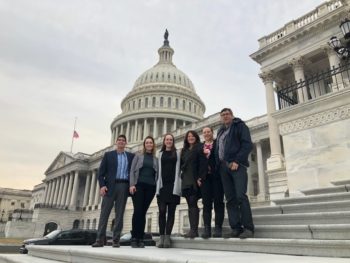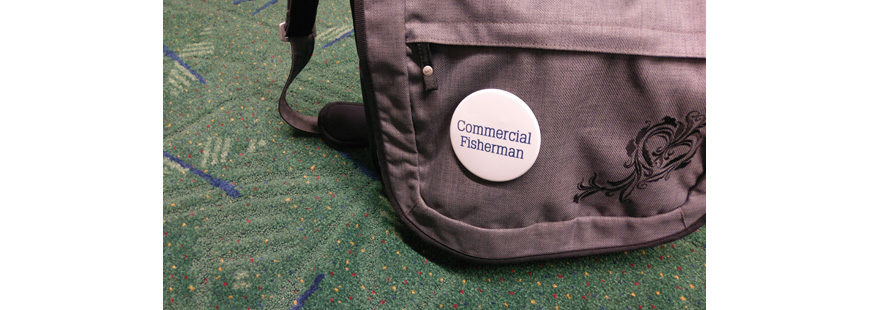Our flight banked beside the National Mall on approach as the sun set orange over Washington, D.C. This was my first trip back since I left my job as a Senate staffer eighteen months before. Some of the fishermen flying in with me had never made this landing; some, like me, had seen it many times. This time I was a constituent representing my community, an Alaskan, and a fisherman. Much like before, my job on this trip was to connect Alaskans to their representatives in our nation’s capital. But now, I was also here to share my own story.

Alaska Marine Conservation Council’s Grace Allan, Jamie O’Connor, Jason Dinneen, Celeste Beck-Goodell, plus Alaska Longline Fishermen’s Association’s Tara Racine and Jeff Farvour.
“My name is Jamie O’Connor and I’m a fifth-generation salmon fisherman from Bristol Bay,” I’d begin. “I was fortunate enough to grow up fishing with my parents and great-grandparents, which gives me a special, long view on what happens when you manage your resource for sustainable harvest. In Bristol Bay, it’s resulted in the largest, most sustainable salmon fishery in the world.” I’d pause, waiting for that fact to sink in before continuing. “And we maintain those runs through strong, science-based fisheries management. So, I’m here to ask that we maintain that focus in the Capitol, fund the necessary science, and use it to ensure that my great-grandchildren, and the generations that follow them, may benefit from the fishing culture and livelihood that has given me so much. Someday it will be their turn to feed the world.”
I repeated that introduction thirteen times over two days with varying deliveries to offices on and off the Hill. So did the eight other fishermen in our group. Each of our stories were a little different. Each supported the science-based management policy we’d flown 4,000 miles to discuss. And each story connected the staffer or Congress Member sitting across the table to our fisheries and our community in its own way. Sharing your story is sometimes all you can do to stand up for what you and your industry need, young fishermen. So don’t be afraid to trade out your slickers for a blazer once in a while. This work is equally important, and we can’t keep fishing without it.



The Native Village of Nelson Lagoon Needs Your HelpI am writing on behalf of the Native Village of Nelson Lagoon. Below I provide my abbreviated proposal explaining how I believe management would be more adequately achieved and environmentally sound, and harvests would improve in the future. I have attached my full proposal as sent to Board of Fish. The Alaska Department of Fish & Game Board of Fish (ADF&G BOF) reviews the regulations for Area M which includes the Nelson River about every three (3) years. However, due to the urgency of fish decline the ADF&G have decided to review the regulations this year.The people of Nelson Lagoon have been telling ADF&G BOF for the past 30+ years that the Nelson River Salmon System would decline and eventually wind up desolate. Our statements predicting what would happen is happening. ADF&G has denied any issues raised that have anything to do with the decline, soon to be extinct, Nelson River Salmon System (arguably the largest salmon system on the north Alaska Peninsula). Undoubtedly, Nelson River is one of only 2 systems that make up nearly 90% of the total North Alaska Peninsula salmon seasonal escapement. Yet 90% of harvests regularly are 100 miles away from these rivers. Nelson River’s harvest was a meager 3% of 2021 season total harvest. Area M Salmon harvests have been studied (WASSIP), and it confirms that all of Area M harvests effects all of Alaska lakes, rivers, and streams. The study includes Russian salmon interception. Area M fishery effect all Alaskans in one form or another and can be categorized as one of Alaska’s biggest issues if it were to disappear. The issues stemming from loss of the fishery include subsistence lifestyles, environmental, political, and financial to simply name a few. Area M, in my opinion, is over-fished in its local stocks year after year. The WASSIP study is extremely biased and flawed when discussing ADF&G BOF proposals.The Native people of the Alaska Yukon Kuskokwim Delta (AYK) argued heavily in the mid 1980’s and as a result ADF&G BOF reduced the net depth of Area M south peninsula by 25%. The BOF then made further changes by increasing net depth of North Area M nets by 25%. This provided for an increase of net in north Area M by 36% due to already standing difference in net depth. Such a deepening of the net allows for an exceptional increase in catch per day. Today, those fisherman pack, almost overburdening, nearby canneries because of the harvest volume per day and are quickly put on a catch limit.Not only are the nets deeper in North Area M, but the ADG&F have not restricted mesh size. Setting restrictions on the mesh sizes increases harvests of mature spawning salmon, letting an even greater number of small, immature, unable to spawn salmon reach river systems. North Area M fisheries are allowed earlier harvest timeframes that, traditionally, were not harvested in that time of the salmon’s migration. This allows for salmon to be harvested before the major quantity of escapement critical for salmon to reach rivers. Harvests areas farthest up the coast, in my opinion, are only to intercept more North bound salmon returning to Bristol Bay.Since North Area M has been so profitable throughout the years, Area M permits that were not normally used in the north area, are now being fished in the north salmon harvests, having an added impact. Currently, Chignik is a local Alaska Peninsula salmon stock. My current understanding is that area is the only substantial sockeye salmon river on the south Alaska Peninsula. Chignik is fighting Area M fisherman for interception of their salmon, as the Native Village of Nelson Lagoon.ADF&G management have fought against our earlier proposals for “windows” because they do not see the big picture. Now, ADF&G is using the WASSIP study against us. The ADF&G have refused to take into account traditional indigenous knowledge learned about the area over the thousands of years our Native people have lived in the area. Unless ADF&G make changes soon, the fisheries will likely not last through the next generation.I am requesting publication and support for my proposal submitted to BOF, from conservation to local entities and any individual or group who has an interest in the matter. This proposal is a short summary of a more in depth letter that will be provided publicly. If ADF&G would like a copy of that letter I am more than happy to provide a copy.